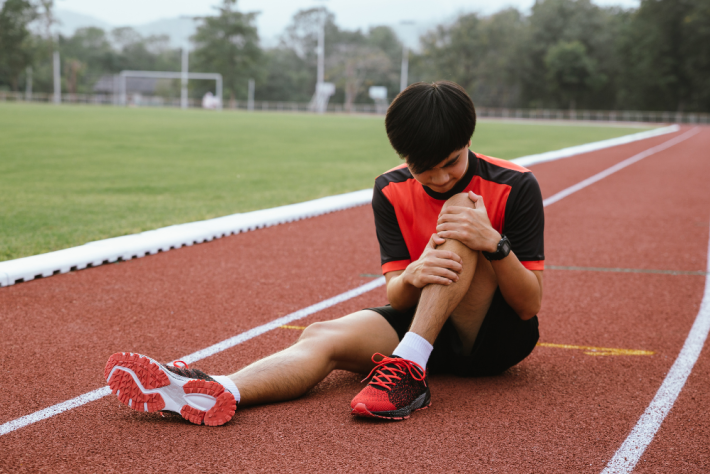
Knee injuries are a common concern among young athletes, especially those involved in sports that require running, jumping, and sudden changes in direction. Whether caused by acute trauma or repetitive overuse, knee injuries can significantly impact a young person’s physical activity and overall well-being. Understanding how to prevent and treat these injuries is crucial for maintaining their health and allowing them to continue enjoying sports and physical activities.
Common Causes of Knee Injuries in Youth
Knee injuries in children and adolescents can arise from various causes, broadly categorised into acute and chronic injuries:
- Acute Injuries: These occur suddenly, often as a result of a traumatic event. Examples include ligament tears, such as an anterior cruciate ligament (ACL) injury, or meniscus tears, which can happen during activities like Aussie Rules Football, basketball, or gymnastics. A sudden fall, twist, or collision can lead to these painful and often debilitating injuries.
- Growth Related and Chronic Overuse Injuries: These injuries develop gradually over time due to repetitive stress on the knee joint. Young athletes who participate in sports that involve frequent running, jumping, or squatting are particularly at risk. Knee symptoms that occur during or following periods of growth are also common when coinciding with intense athletic activity. Conditions such as patellar tendinitis (commonly known as jumper’s knee) and Osgood-Schlatter disease are examples of overuse injuries that can cause significant discomfort and limit an athlete’s performance.
Prevention of Knee Injuries
Preventing knee injuries in young people requires a combination of proper training, technique, and conditioning. Here are some key strategies to reduce the risk of knee injuries:
- Proper Warm-Up and Cool-Down: Starting each practice or game with a thorough warm-up helps prepare the muscles and joints for physical activity, reducing the risk of injury. Similarly, cooling down after exercise helps the muscles recover and prevents stiffness.
- Strengthening and Flexibility Exercises: Strengthening the muscles around the knee, such as the quadriceps, hamstrings, and calf muscles, can provide better support for the knee joint. Incorporating exercises that improve flexibility, such as stretching or yoga, can also help reduce strain on the knee. You can read our blog on strength training for youth here for tips on how to do this safely.
- Proper Technique and Form: Teaching young athletes the correct techniques for jumping, landing, and pivoting can significantly reduce the risk of acute knee injuries. Coaches and trainers should emphasise the importance of maintaining proper form during all activities.
- Adequate Rest and Recovery: Overtraining can lead to overuse injuries. It’s important for young athletes to have adequate rest between training sessions and to listen to their bodies. If they experience pain or discomfort, they should rest and seek professional advice.
- Use of Protective Gear: In some sports, wearing appropriate protective gear, such as knee pads or braces, can help prevent injuries. This is especially important for contact sports or activities with a high risk of falls or collisions.
Treatment of Knee Injuries
When a knee injury does occur, prompt and appropriate treatment is essential to ensure proper healing and prevent long-term complications. Here are the general steps involved in treating knee injuries in young people:
- Initial Rest and Immobilisation: After an acute knee injury, it’s important to rest the knee and avoid putting weight on it. In some cases, immobilisation with a brace or crutches may be necessary to prevent further damage.
- Ice and Elevation: Applying ice to the injured area and elevating the leg can help reduce swelling and pain in the initial stages of the injury.
- Physiotherapy: A physiotherapist such as Morley Physiotherapy can play a crucial role in the recovery process. They will design a rehabilitation program tailored to the specific injury, focusing on restoring strength, flexibility, and range of motion. Physiotherapy also helps prevent future injuries by addressing any underlying weaknesses or imbalances.
- Gradual Return to Activity: Returning to sports or physical activities should be gradual and closely monitored. The young athlete should only return to full activity once they have regained their strength, flexibility, and confidence in the knee.
- Surgery: In severe cases, such as a complete ligament tear or a significant meniscus injury, surgery may be required. Post-surgery, a comprehensive rehabilitation program is essential to ensure a full recovery.
Knee injuries in young athletes can be both painful and disruptive, but with the right prevention and treatment strategies, the risk can be minimised. Proper training, conditioning, and attention to technique are key to preventing injuries, while early intervention and professional care are crucial for effective treatment. By taking these steps, young athletes can stay healthy, active, and free from knee injuries, allowing them to enjoy their sports and physical activities to the fullest.
If you’re in search of a Noranda physio, contact our team based in Morley to schedule your consult and ensure you stay strong and healthy.
Disclaimer: Please be aware that the information and suggestions presented on this website are meant for general educational purposes only and do not serve as a replacement for professional medical advice. We advise you to seek the guidance of your healthcare provider or contact us directly if you have any physiotherapy health concerns.
